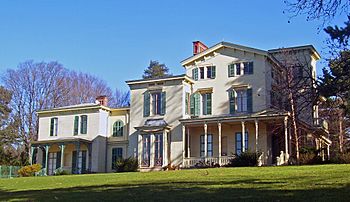Nuits (Irvington, New York) facts for kids
Quick facts for kids |
|
|
Nuits
|
|

West elevation, 2009
|
|
| Location | Ardsley-on-Hudson, NY |
|---|---|
| Nearest city | Yonkers |
| Area | 4.5 acres (1.7 ha) |
| Built | 1852 |
| Architect | Detlef Lienau |
| Architectural style | Italian villa |
| NRHP reference No. | 77000986 |
| Added to NRHP | 1977 |
Nuits, also known as the Cottenet–Brown House, is a beautiful house in the Italian villa style. It is located in the Ardsley-on-Hudson area of Irvington, New York, United States. This stone house was built in the mid-1800s.
In 1977, Nuits was added to the National Register of Historic Places. This means it is an important historical building. It is the only remaining early home designed by the architect Detlef Lienau. Over the years, famous people like Cyrus West Field and John Jacob Astor III owned it. Today, it is still a private home.
Contents
The Story of Nuits
Early Owners and Design
The first owner of Nuits was Francis Cottenet. He came to the U.S. from France in 1822. He started a successful business in New York that bought and sold goods from other countries. After 30 years, he hired Detlef Lienau to design his new home. Lienau was an architect from Europe who worked in America.
Nuits was first built on a very large piece of land, about 65 acres. It was the only house between the Albany Post Road (now US 9) and the Hudson River. Lienau wanted the house to look like real European villas. So, he insisted on using special French stone for its construction.
A few years after moving in, Cottenet asked Lienau to make the house bigger. The Lord and Burnham Company, which was nearby, built the beautiful glass conservatory. People traveling on steamships up the Hudson River often pointed out Nuits. It was seen as the perfect home for a wealthy person.
Changes in Ownership
After Francis Cottenet passed away in 1884, the house was bought by Cyrus West Field. He was another rich person from the area. However, he had to sell Nuits just one year later because of some money problems.
When Field sold the house, he added special rules to the deed. These rules said that Nuits could not be used for certain things, like factories or schools. It also could not be sold to "disreputable" people. These rules are still in place today. They have made sure that Nuits has always been used as a private home.
John Jacob Astor III bought Nuits from Cyrus West Field. He lived there for a few years. During that time, he spent a lot of money, about $100,000, to make improvements. He also built the stone gate that you can still see on Route 9 today.
After Astor's death, his family sold the house to Manhattan College. The college tried to get rid of the rules that Cyrus West Field had put in the deed. They wanted to use the house for their school. But they could not change the rules. So, the college sold Nuits to Amzi L. Barber. He was known as the "Asphalt King" because he was a leader in paving roads. Barber sold off most of the land around Nuits. This allowed the area of Ardsley-on-Hudson to grow and develop.
Recent History
Since then, Nuits has been home to several other people. These include engineer Robert Hewitt, Jr., coffee company owner James Henry Schmelzel, and investment banker Martin W. Dolan.
The house went through a big restoration project that lasted almost 20 years. It was finished in 2000. From 2000 to 2015, the house was also greatly updated inside.
About the Building
Nuits is built in a clever way, using many connected stone blocks. These blocks are made of smooth Caen stone. The stones are placed so tightly together that you can't even fit a small knife between them. The roofs are gently sloped and have decorative brackets under the edges.
Outside Features
The main entrance is on the south side of the house. It has an arched doorway and a central tower. Above the entrance is a balcony with a railing and a window with a hood. This entrance has been compared to the one designed for Princeton University's Nassau Hall. Long porches, called verandas, run along the south side of the house.
On the east side, you can see an eight-sided conservatory with a pointed roof. This room was added a few years after the house was first built. The north side of the house has a room that was once used for billiards. Today, it is a family room. The west side of the house looks out over the Hudson River and has not been changed.
Inside the House
When you enter Nuits, you step into a central hallway that goes through the whole house. To the east of the hall is a library with French doors. Across from the library is the main living room.
There is only one other building on the property. It is a small cottage for a caretaker. This cottage was added later. It is considered an important part of the property's historical look.
Images for kids


